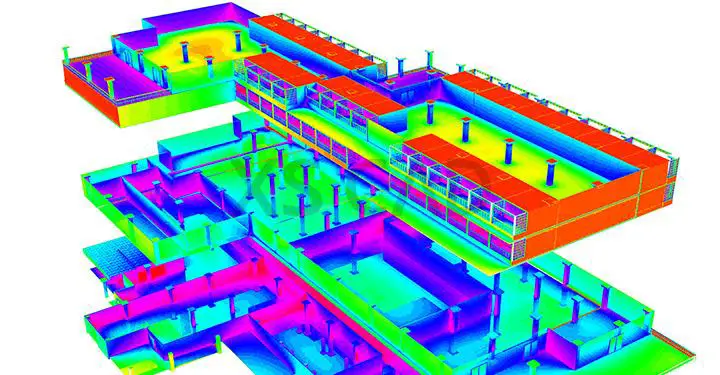Our Articles

Can CFD Help Solve Building Engineering Design Challenges?
Though building engineering design may necessarily navigate through a multitude of challenges, one of the prime aspects of MEP design is the creation of reliable and accurate HVAC design. Computational fluid dynamics, or CFD, can make a significant contribution in the design assessment and study of the HVAC system. The fruit of precise CFD analysis by knowledgeable HVAC mechanical engineering consultants is far from being forbidden anymore with the right HVAC design services and HVAC drafting services support.
Buildings, places where occupants live, learn or work, need to provide a comfortable environment that shelters people from the heat and cold outside. The absence of comfort in an indoor space can be detrimental to general health and can even affect mental focus. It is thus important to ensure optimal thermal comfort inside.
When fluid flow simulation, part of CFD analysis, is incorporated into HVAC design, thermal comfort can be assessed, analysed and optimised.
How can this be?
Software enabling CFD analysis helps investigate air flow patterns, distribution of temperature, radiation and heat transfer. The software can show the location where heat is escaping, where ventilation is poor and where cold spots occur. During the course of CFD simulation, various stakeholders can add data and designers can view and test every part of the HVAC system.
Engineers have access to accurate data and simulation results so that they can analyse both new buildings and existing buildings before suggesting improvements, cutting costs and reducing the need for physical resources.
CFD Analysis & Thermal Comfort
So, how does CFD analysis help regulate thermal comfort and indoor air quality?
Basically, by using heat transfer simulation.
Thermal comfort and indoor air quality are clearly defined by regulation in public spaces. Building codes specify requirements for approval for drafts, heating, cooling, contaminant control or smoke extraction that must be satisfied. Factors can include fixed conditions or varying conditions, such as the number of occupants entering or exiting a space, which can affect radiative warmth. Using CFD simulation, an engineer can visualize and assess the relevant factors, ensuring that the design of indoor areas will be comfortable in the face of sudden drafts or temperature increases.
Simulation software for CFD can help optimise HVAC system performance early on in the design workflow. Natural convection, draft velocity and temperature distribution can be assessed. These and other simulation results help develop an efficient and comfortable design that complies with local standards.
In modern times, CFD simulation can occur online, helping test and improve designs and also model various heating or cooling sources. Engineers can create thermally optimised designs and decide the best locations to place heating, air-conditioning or ventilation systems.
Analysing CFD simulations can also be useful for high-risk environments, such as laboratories, storage facilities for drugs and agricultural produce, health care facilities and specialised vaults, where precision control of temperature, humidity or air quality is required.
What to Check
To check whether a building would benefit from CFD analysis, check the following:
Building Engineering Design Challenges
Other types of building engineering design challenges that CFD analysis can help with are the design of:
Techniques developed through CFD analysis can help determine the age of air in a room and can represent pollutant emission sources, chemical reactions and thermal effects in the models so that pollutant concentrations can be analysed, helping to optimise the HVAC system from the pre-design stage.
The dispersion effect on chemical compounds that the air impulsion from an HVAC system can cause can be properly analysed with a CFD model, along with the study of alternatives in the flow inputs, system location and effect of the different sources.
It becomes apparent that CFD design, analysis and simulation can help maintain building thermal comfort, optimise building air quality and aid in the management of several building engineering challenges. Reliable and experienced providers of MEP design services can provide valuable CFD consulting support to enable these design solutions, many of which can be sourced overseas today.
XS CAD has valuable experience providing CFD consulting services, CFD analysis services and MEP design services. Our range of services for HVAC mechanical engineering consultants across the world include HVAC design services, HVAC drafting services and CFD design support. We create these models and drawings, calculations using Revit, AutoCAD, PyoSim, Fire Dynamics Simulator, and BIM Collaborate Pro for cloud collaboration.

